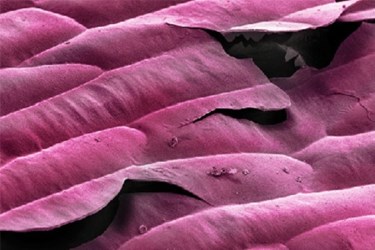Advancements And Benefits Of Electron Microscopy In Food QA/QC Practices
By Isaac Fletcher, contributing writer, Food Online

Advances in scanning electron microscopy and thermal-stage microscopy are improving quality-control procedures for the food industry by broadening sample range and improving analysis capabilities
Within recent advancements of scanning electron microscopy (SEM) are modifications to instruments, allowing for rapid, onsite sample analysis. This has reduced turnaround time for work that would otherwise be outsourced. Additionally, SEM and thermal-stage technology enable food producers to perform onsite analyses in as little as 15 minutes.
SEM technology functions by revealing information about the changes in microscopic properties and particles and how those changes may affect the structural properties of food products. For example, quality-control scientists can measure the temperature at which the coating of a candy bar will begin to gelatinize. SEM can also be used alongside energy dispersive X-ray spectrometry (EDS) in order to map contamination analysis.
Achieving Global Certification In Food Safety & Quality
Earlier incarnations of bench top SEMs were restricted to one accelerating voltage, which severely limited resolution capability. Advancements in the technology have led to the creation of bench top SEMs with as many as three accelerating voltages, high- and low-vacuum modes, and the ability to detect secondary and/or backscattered electrons. Improvements like these enable quality-control teams to analyze a broader range of samples and achieve higher resolution imaging, which are excellent tools for conducting food analysis.
When it comes to food analysis, maximum specimen size and total sample travel range are both very important factors. While older bench top SEMs were only capable of analyzing samples up to 25 mm in diameter, new technology allows for the analysis of objects up to 70 mm in diameter and 50 mm thick. A larger sample size translates to a wider range of potential samples and decreased sample preparation time.
Resolving Quality Issues In Food Manufacturing With Advanced Data Analysis
Similarly, advancements in thermal microscopy allow for a much wider range of substances — notably, starch grains — to be analyzed. Starches are broken down in the presence of water and heat, a molecular process known as starch gelatinization. Thermal microscopy can provide important insights for food scientists looking for ways of preserving starch grain integrity in various environments.
Microscopy techniques are important not only for the analysis of food, but for food packaging as well. Quality-control teams can use microscopy to investigate the corrosion, leakage, or the properties of multi-layered film. The ability to analyze multi-layered plastics while exposing them to various environmental conditions has become an important component of packaging quality control. Analysis afforded through the use of SEMs reveals important information about changes in the packaging’s microscopic properties and particles that could affect those properties.
